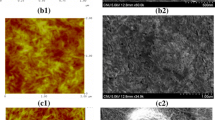Abstract
The porous carbons derived from cellulose are renewable and environmentally friendly. Coconut shell and wood derived porous carbons were characterized with elemental analysis, ash content, X-ray diffraction, infrared absorbance, particle size, surface area, and pore volume. The results were compared with carbon black. Uniaxial deformation of natural rubber (NR) composites indicate the composites reinforced with the porous carbon from coconut shell have higher tensile moduli at the same elongation ratio than the composites reinforced with wood carbon. 40 % coconut shell composite showed a fivefold increase in tensile modulus compared to NR. Polymer–filler interactions were studied with frequency dependent shear modulus, swelling experiments and dynamic strain sweep experiments. Both linear and non-linear viscoelastic properties indicate the polymer–filler interactions are similar between coconut shell carbon and wood carbon reinforced composites. The swelling experiments, however, showed that the polymer–filler interaction is greater in the composites reinforced with coconut shell instead of wood carbon.








Similar content being viewed by others
References
Kang BS, Lee KH, Park HJ, Park YK, Kim JS (2006) J Anal Appl Pyrol 76:32–37
Pastor-Villegas J, Pastor-Valle JF, Meneses Rodriguez JM, Garcia Garcia M (2006) J Anal Appl Pyrol 76:103–108
Antal MJ, Gronly M (2003) Ind Eng Chem Res 42:1619–1640
Gamage NJW (1987) M.S. Thesis, University of Moratuwa, Sri Lanka
Favier F, Chanzy H, Cavaille JY (1995) Macromolecules 28:6365–6367
Qi Q, Wu Y, Tian M, Liang G, Zhang L, Ma J (2006) Polymer 47:3093–3896
Angellier H, Molina-Boisseau S, Lebrun L, Dufresne A (2005) Macromolecules 38(9):3783–3792
Greve HH (2000) Rubber, 2. Natural. In Ullmann’s encyclopaedia of industrial chemistry. Wiley-VCH, Weinheim
Pearson CH, Cornish K, Rath DJ (2013) Ind Crops Prod 43:506–510
Barnard D, Lewis PM (1988) In: Roberts AD (ed) Natural rubber science and technology. Oxford Unversity Press, Oxford (Chapter 14)
Archer BL, Barnard D, Cockbain EG, Dickenson PB, McMullen AI (1963) Chapter 3, structure, composition and biochemistry of Hevea latex. In: Bateman L (ed) The chemistry and physics of rubber-like substances. MacLaren & Sons, London
Wang MJ (1998) Rubber Chem Technol 71:520–589
Leblanc JL (2002) Prog Polym Sci 27:627–687
Lyon F, Burgess K (1985) Carbon black. In: Kroschwitz JI (ed) Encyclopaedia of polymer science and engineering, 2nd edn. Wiley, New York
Brunauer S, Emmett PH, Teller E (1938) J Am Chem Soc 60(2):309–319
Lippens BC, de Boer JH (1965) J Catal 4(3):319–323
Bickford ES, Clemons J, Escallón MM, Goins K, Lu Z, Miyawaki J, Pan W, Rangel-Méndez R, Senger B, Zhang Y, Radovic LR (2004) Carbon 42(8–9):1867–1871
Biscoe J, Warren BE (1942) J Appl Phys 13(6):364–371
Houska CR, Warren BE (1954) J Appl Phys 25(12):1503–1509
Ungar T, Gubicza J, Ribarik G, Pantea C, Zerda TW (2002) Carbon 40:929–937
Misra MK, Ragland KW, Baker AJ (1993) Biomass Bioenergy 4(2):103–116
Trabelsi PA, Albouy P-A, Rault J (2003) Macromolecules 36:9093–9099
Trabelsi PA, Albouy P-A, Rault J (2002) Macromolecules 35:10054–10061
Mark JE, Erman B (1988) Rubberlike elasticity: a molecular primer. Wiley-Interscience, New York
Payne AR (1963) J Appl Poly Sci 7:873–885
Maier PG, Goritz D (1996) Kautsch Gummi Kunstst 49:18–21
Meera AP, Said S, Grohens Y, Thomas S (2009) J Phys Chem C 113:17997–18002
Williams ML, Landel RF, Ferry JD (1955) J Am Chem Soc 77:3701–3707
Vilgis TA, Heinrich G, Kluppel M (2009) Reinforcement of polymer nano-composites—Theory, experiments and applications. Cambridge University Press, Cambridge
Stockelhuber KW, Svistkov AS, Pelevin AG, Heinrich G (2011) Macromolecules 44:4366–4381
Rooj S, Das A, Stockelhuber KA, Wang D, Galiatsatos V, Heinrich G (2013) Soft Matter 9:3798–3808
Kraus G (1963) J Appl Polym Sci 7:861–871
Cunneen JI, Russell RM (1969) J Rubber Res Inst Malaya 22(3):300–308
Acknowledgments
The authors would like to thank A. Thompson for energy-dispersive X-ray analysis, A. J. Thomas for ash analysis, G. Gross for X-ray measurements, and A. Maness for elemental analysis.
Author information
Authors and Affiliations
Corresponding author
Additional information
Mention of trade names or commercial products in this publication is solely for the purpose of providing specific information and does not imply recommendation or endorsement by the U.S. Department of Agriculture. USDA is an equal opportunity provider and employer.
Rights and permissions
About this article
Cite this article
Jong, L., Peterson, S.C. & Jackson, M.A. Utilization of Porous Carbons Derived from Coconut Shell and Wood in Natural Rubber. J Polym Environ 22, 289–297 (2014). https://doi.org/10.1007/s10924-013-0637-4
Published:
Issue Date:
DOI: https://doi.org/10.1007/s10924-013-0637-4




